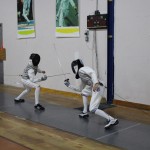
Practice Bouting: Competitive vs. Skill Enhancement
Over the course of your fencing career, you are going to spend a lot of time training with practice bouts; 5 touch, 15 touch, mock team matches, open bouting, tactical bouting. There’s many different types of bouting you’ll do. So what are some ways you can gain the most out of all this practice fencing? It really comes down to two different types of bouting and having the right mindset for each one.
Skill Enhancement Bouts
Skill enhancement bouting focuses on improving an individual skill set. For example, perhaps you need to improve on your footwork, you’ll spend the entire bouting time on making sure your footwork is correct with small steps and bent knees, and maintaining correct distance with your opponent. Or perhaps you need to work on setting up false counter attack parry riposte, you’ll first work on creating the right opportunity to do false counter and provoke your opponent to finish, then focus on the timing and technique of your parry riposte until the whole action comes together. In skill enhancement bouting you dedicate your energy to strengthening new skills or weak areas of your fencing rather than trying to win every touch.
This type of bouting can be mentally difficult. Skill enhancement bouting requires discipline, concentration, and the ability to set aside your ego. When you first begin to work on a new skill or a weak point in your fencing, you will lose a lot of touches and may lose entire bouts to fencers you may have more experience than. But that’s okay! Remember, there is no trophy awarded for winning all your practice bouts, and by spending this time to perfect each individual skill, you are setting yourself up for better long-term success. The important thing here is to remain patient and determined in your progress. Instead of judging your success based on how many touches you earn, you measure your success based on how close you are to performing the skill correctly.
Competitive Bouts
Competitive bouting is exactly what is sounds like. The objective of competitive bouting is to use the skills and tactics you’ve perfected (in your skill enhancement bouts) to win touches. Like skill enhancement bouting, there are specific elements you can still focus on within competitive bouting. You can practice changing up actions from touch to touch, your strip demeanor (looking and feeling confident on the piste goes a long way to helping your game), and managing your energy level (figuring out where you need to breath and stay calm or if you need to energize and yell). Competitive bouting is where you start to bring all the individual aspects and skills together to create a well rounded fencing game and work on performing these skills at a higher intensity.
When you are thinking of bouting ratios, only about 20% of your bouting time should be committed to competitive fencing in practice, while the other 80% of the time should be devoted to skill enhancement. Why? Think about it this way: in order to win, you must first be able to earn the required number of touches. In order to get a single touch, you first need to be able to successfully perform a chosen action. In order to execute that action, you must be able to execute the right timing, footwork, and technique correctly for it to work. In order to have correct footwork, timing, and technique requires practice. And if you only do competitive bouting, you’ll never be able to execute actions you haven’t perfected yet because you’ll like lack the confidence and actual ability to perform it correctly. With skill enhancement bouting, you can build your confidence as each individual skill gets stronger.
As you progress, you can start to crossover skill enhancement with competitive bouting. Challenge yourself to win bouts while only using 1 or 2 designated actions that you’re working on. This will help you be able to perform these actions under higher pressure situations, and help to elevate the challenge level when practicing with less experienced fencers.



